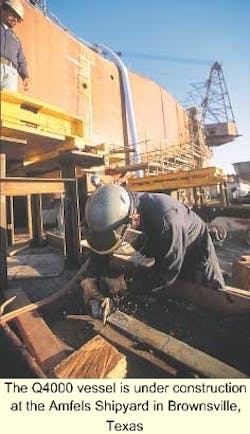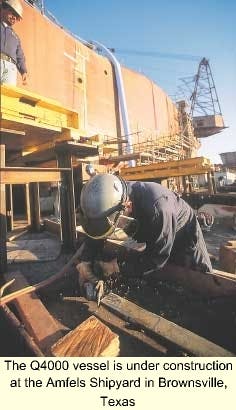OFFSHORE CONSTRUCTION: Q4000 banking on intervention work to replace full-size drilling rigs
Under construction at the Amfels yard in Brownsville, Texas is a semisubmer-sible that can operate in 10,000-ft water depth, and if things go as planned, it will never drill a well.
In 1995, Cal Dive purchased the Uncle John, a large semisubmersible (semi) originally constructed for Shell in 1978. The vessel was converted into an installation platform and has been working in the Gulf of Mexico ever since.
In retrospect, the Uncle John seems a natural purchase for Cal Dive, but at the time this was seen, internally at least, as a very aggressive move for a then small contractor. Cal Dive CEO Owen Kratz said his company was interested in deepwater well intervention as well as construction contracts, which meant it needed a vessel capable of installation work in deepwater.
In addition to a vessel, the company needed outside expertise to pursue deepwater intervention work from the Uncle John. Cal Dive teamed with FMC for its subsea equipment and know-how, and Schlumberger for the companies technology and experience below the mudline. Although this alliance was loosely structured in the early days, it paid off for everyone involved.
The unit filled a much-needed role of intervention and installation work that would otherwise have to be performed by a drilling rig. In the mid-1990s, day rates were on the rise, as they are now, and rigs were difficult to find. To justify the economics of many intervention projects, an alternative to a drilling rig was needed. That alternative in many cases was the Uncle John.
While a versatile workhorse, the unit is a conversion, and was not originally designed to perform these activities. The longer Cal Dive, FMC, and Schlumberger worked on the Uncle John, the more areas of improvement the companies identified. As exploration drilling moved further off the shelf, it became clear that wells would be produced in ultra-deepwater. If wells were to be produced, they would at some point require intervention work.
Q4000 design
This was the logic behind the design and construction of the Q4000 (Q stands for quantum; 4,000 is the variable deck load in tons). First steel was cut in January of 1999. Kratz said at that time, the company had four years of "trial and error" with the Uncle John, giving it some specific ideas about what this new vessel should and should not be capable of.
The well-life approach to a contract, which is the basis for the Q4000's construction, was something Schlumberger was already pursuing. It tied in naturally with the companies smart well designs and reservoir management technologies.
While Schlumberger is committed to a life-of-field approach to reservoir management, access to the asset is not critical path, said Kurt Hurzeler, Schlumberger Service Coordinator. The company brings a range of downhole intervention and completion services supported by engineering expertise and sophisticated logistical support. Hurzeler gave the example of the DeepSTIM, and DeepSTIM II among the largest stimulation vessels working in the Gulf of Mexico. Access to these vessels expands the Q4000 capabilities to include formation fracturing or rapid well displacement in deepwater.
More deckload
One of the main considerations in designing this vessel was to get the most deckload out of the design. Kratz said Cal Dive could have made the vessel larger, but to fit its niche, it had to be cheaper than a comparable drilling rig. This was accomplished by reducing the amount of steel used wherever possible. In addition to reducing steel use in the design, Kratz said Amfels was offered a performance incentive to reduce steel used in the construction. He said Cal Dive relied on Amfels' experience to identify areas where the steel weight could be reduced.
Beyond constructing a lighter, stronger vessel, Cal Dive believed in taking advantage of emerging technologies. The use of composite materials, expandable tubulars, and other developing technologies, according to Cal Dive Vice-President Andy Scott, will have a dramatic impact on the deck capacity required for this type work in the future. Those who over-build, he said, will be saddled with more rig than they need.
Structural considerations
The deck itself was made very flat and open, with plenty of room for equipment to be stored and handled. The deck does not descend very far between the columns, and there are no crossmembers connecting the columns. This was a critical design challenge. Crossmembers can interfere with maneuvering large pieces of equipment below the moon pool for installation. But the reason virtually all semis have such members is because of their natural tendency for high design stresses and potential structural fatigue down the middle of the hull.
On the Q4000, the needed stability was achieved using technology borrowed from the aerospace industry. Airplane wings naturally want to tear away from the fuselage of a plane. They are held in place not with crossmembers but with haunches under the base of the wing. The same design was used in connecting the deck to the pontoons. Without crossmembers, it is possible to transport subsea equipment on a dynamically positioned barge, and park that barge in a stationary position between the Q4000's pontoons for hookup prior to installation.
For a variety of reasons, the Q4000 was conceived from the start as a US-flagged vessel. When operating in US waters, it can go into a US port, pick up equipment, and transport that equipment to the installation site. Vessels under foreign flags must have this equipment ferried out. Another advantage of the US flag is that the Q4000 could qualify for funding from the US Maritime Administration, which is charged with encouraging innovative vessel designs and increasing the number of US flagged vessels.
While shipyards outside of the US were considered, Kratz said there are a number of factors that encouraged Cal Dive to buck the trend of overseas construction. With a yard located in Brownsville, Cal Dive's representative could closely monitor progress. As the vessel nears completion, Kratz said the yard will allow Cal Dive to take clients on a tour. So far the project is on schedule and should be completed this summer, with sea trials scheduled for August 2001.
Deepwater intervention
Because it will be working in ultra-deepwater, the Q4000 is equipped with DP3 (dynamic positioning) capability. Four azimuthing thrusters and three engine rooms ensure the vessel can hold station in deepwater without the need for a mooring system. The thrusters are retractable so the vessel can maneuver into shallow water ports to take on equipment. Under its own power, the Q4000 can make 12-13 knots. Kratz said such speed is a critical component to the vessel's strategy. This allows the Q4000 to travel quickly between jobs in the Gulf, when working on several projects consecutively.
"Within 24 hours, we can mobilize from one type of project to another," Scott said. Because many of the crewmembers learned on the Uncle John, they have experience performing a variety of installation, construction, and intervention work. New crewmembers will be brought on from Cal Dive, FMC, and Schlumberger. The vessel can support a complement of 136, but most will be experienced workers trained on the Uncle John.
Versatility
While it can move quickly from one field to another, the Q4000 was designed to perform a variety of activities on one field that would minimize the time a drilling rig would be needed. The vessel could for example, perform coring work, drive in caissons, preset the 20-in. or 30-in. casing strings, then move to another job while the well is drilled.
Once the well is finished, the Q4000 could return to clean and test the well and set the tree. With J-lay equipment, the vessel could also lay infield flow lines. The vessel could also install and remove mooring lines for the drilling rig and perform repair, maintenance and intervention work later in the field's life.
FMC is outfitting the Q4000 with a steel, mono-bore riser system that can be used for subsea intervention and completion work. This riser is an extension of systems FMC has in the field, with the difference being that this riser can access wells in water depths up to 10,000 ft, and well pressures up to 15,000 psi. Robert Writt of FMC said the firm is building this riser to meet the future demands of deepwater, for which operators are already planning. Both horizontal and conventional subsea trees needing intervention work can use this riser.
The riser will make use of a composite reelable 2-in. flexible pipe. This allows for the circulation of fluids, flow testing and for hydrate remediation of the subsea well. Because of the risers slim bore, 5.25-in. internal diameter, it can be handled easier and run much faster than a conventional marine riser system. "We can be latched onto the tree within six hours of arriving on station," Writt said.
Using the FMC riser for a conduit to the well, Schlumberger can provide a suitable downhole completion profile of the well for the Cal Dive drillers. In this way, each member of the team alliance works together while sticking with his core competencies.
One feature of the Uncle John that was translated to the new vessel is the dual crane system. This has proved very useful in handling long tubulars and other over-sized loads. Improving on the original design, Huisman Itrec designed a 360-ton mast crane that adds a second method of accessing the seabed. The cane is capable of transmitting a 110-ton load down 10,000 ft on a single wire. To lower the center of gravity and clear even more deck space, the take-up reel for the crane was moved into the vessel's column, while the reel of wire rope was relocated in the vessel's pontoon. This design helped Huisman overcome some space limitations.
The wire rope used to carry these loads has a 920-mm diameter. To spool 10,000 ft plus of this would require a reel too large for the crane base. To overcome this, Huisman developed a compact traction winch installed in the base of the crane, while the reel itself was transferred to the pontoon. The traction winch can deliver the necessary line pull to lift the load while the storage reel takes up the wire rope under low tension.
To make the best use of all this open deck space Cal Dive will be the first to use Huisman-Itrec's MPT (multi-purpose tower). The MPT has an open derrick design that eliminates the size restrictions of a conventional V-door allowing open access to the block from three sides. This design is ideally suited to an installation vessel. The MPT also has a unique splitable traveling block so that it can handle lighter loads using a smaller number of sheaves. This translates into much faster running times.
While the Q4000 was constructed on speculation, without a payoff contract in hand, Kratz said he is not concerned about finding work for the vessel. In the preliminary research performed prior to building the vessel, it was determined the Gulf of Mexico could easily support another Uncle John.
With the Q4000's extended capabilities, it can perform a variety of work in deep and shallow water. He is confident that the vessel will be coming onto the market at a propitious time. As the market for deepwater and ultra-deepwater drilling rigs continues to tighten, it will become more difficult, and more expensive to secure a drilling rig for this work. Kratz said it is his hope the Q4000 will allow some operators to release drilling rigs from their rig pools and replace them with the Q4000 not only lowering per well costs, but exposure to the cost of unused rig time on a long term contract.

